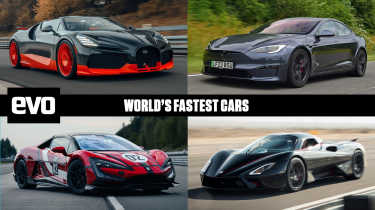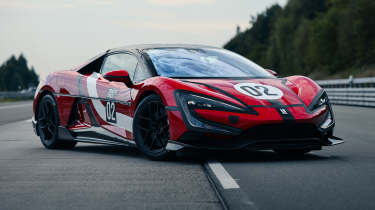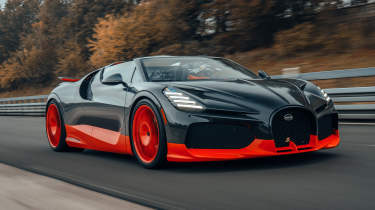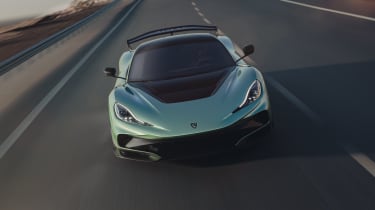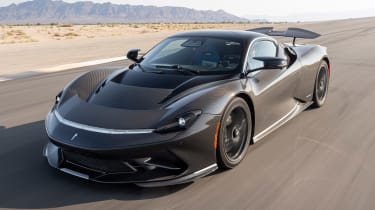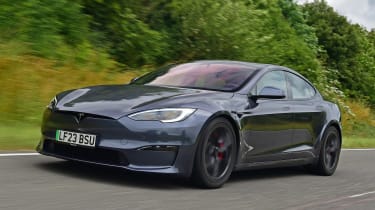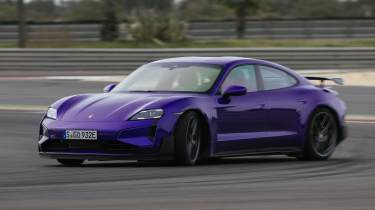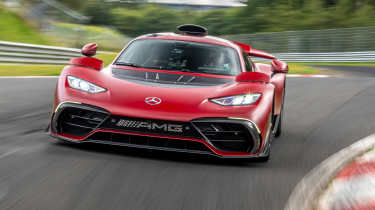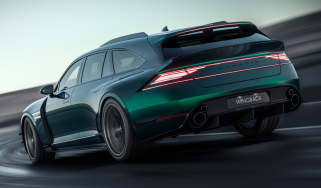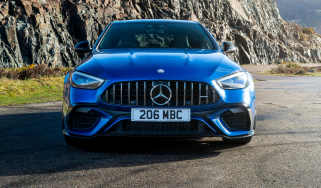Fastest cars in the world 2025 – top speed, acceleration and lap times
Modern cars are more capable than ever, in every metric from acceleration to top speed and lap times. Here's a list of the very fastest
The question of what is the fastest car in the world is a much more complicated one in 2025 than it was 30 years ago. Back then, the fastest flat out also tended to be the quickest to 62mph and against the clock around a circuit. Today, those that have the highest Vmax which we’d traditionally call the fastest, aren’t necessarily the quickest to 62mph. Nor are they the fastest around a track, by virtue of their often low-drag, low-downforce bodywork. So extreme are the endeavours of extreme top speed, acceleration and track performance, that majoring in all three is almost impossible in this day and age.
With that said, top speed remains the most elusive number and source of bragging rights in cutting-edge hypercars. Hitting over 200mph is as revered today as it was two decades ago. By contrast, there are modern hot hatches that’ll get from 0-62mph quicker than the hypercars of the noughties. EVs too have democratised hypercar-like acceleration, with SUVs and family saloons able to crack 62mph in under three seconds.
> The top 10 fastest ever Nürburgring lap times
Likewise, explosive leaps forward in downforce, chassis and tyre tech have seen lap times tumble over the last 20 years, to the point that a road-going Porsche 911 GT3 RS can dispatch its racing cousin on equal tyres over a hot lap. Only a select few cars over the last decade or two however, have pushed the boundaries in terms of top speed. The McLaren F1 went seven years unchallenged and undisputed, as the fastest car in the world. It set its two-way average as well as the mythical de-restricted run to 242.9mph almost 30 years ago. The club of cars capable of such speeds is still vanishingly exclusive given not only the engineering required to make a car so capable, but the space required to test it.
The fastest cars in the world
BYD Yangwang U9 Xtreme – 308.3mph*
Yangwang, a sub-brand of popular Chinese manufacturer BYD, has only existed since 2023, but it's just managed to beat Bugatti at its own game. Taking the existing U9 supercar as a base, the ultra-limited 'Xtreme' (just 30 are set to be produced) lifts performance to a new level entirely, with over 3000bhp (about twice that of the range-topping W16-powered Chiron), semi-slick tyres and uprated 'DiSus-X' suspension to cope with the forces at play.
Like many of the cars on this list, the car that achieved the record was fitted with non-production spec safety additions like a full roll cage, but that's not to say this is not an impressive feat of engineering. At the Automotive Testing Papenburg test track in Germany, German racing driver Marc Basseng took the U9 past both the EV and ICE production records, with a peak speed of 496.22kmh (308.3mph). Like the Bugatti, this was recorded on just a single run as opposed to the two-way average required for an official world record, but then not many manufacturers have abided by these rules for some years now.
*One-way run
Bugatti Chiron Super Sport 300+ – 304.7mph*
Bugatti was the first to break over the 300mph with the Chiron Super Sport 300+ in 2019, but the circumstances of the run were atypical. The run was completed in a prototype Chiron at the Ehra-Lessien test track, and while it did crack 304.7mph, Bugatti only maxed out the car in one direction. Nevertheless, it’s a monumental achievement made possible by the 300+’s modified aero, 1578bhp W16 and the skills of official Bugatti test driver Andy Wallace.
After the 300mph barrier was broken, Bugatti built 30 Super Sport 300+ models for customers to buy, but this time limited to 273mph. Still, they had the same power output as the record car and an extended longtail rear end to cleave through the air more smoothly, plus a bespoke lower diffuser. The steering and suspension calibration were also modified to provide more stability and control – useful in a car that hits 186mph from rest in a scarcely believable 12.1sec.
*One-way run, not production spec
SSC Tuatara – 295mph (one-way run)
Controversy clouded the SSC Tuatara when its makers claimed it had hit 331mph in 2020 to claim the title of world’s fastest car, which turned out to be false. Cue an awkward backtracking from the company and distant laughter from Molsheim and Ängelholm, where top dog hypercar rivals Bugatti and Koenigsegg are based. No matter, because Tuatara still stretches what’s possible from a road-going production car, and has since achieved a verified 295mph one-way run.
That speed isn’t much of a surprise once you’ve read the specs. On E85 fuel the Tuatara puts out a staggering 1750bhp from its twin-turbo, 8800rpm V8, it weighs just 1247kg dry and has a drag coefficient of 0.279 – impressive for a car that needs to cool its monstrous engine and generate enough downforce to stay on the ground at almost 300mph. It may have had a tricky introduction to the hypercar arena, but in pure speed terms its firmly in the big leagues.
Bugatti Mistral – 281.8mph
As if hitting over 280mph wasn’t enough, the Bugatti Mistral also has the accolade of being the world’s fast open top car, beating the previous record holder – the Hennessey Venom GT Spyder – by 16mph. Not a bad way to go out for the final W16-engined Bugatti, ahead of the Tourbillon’s arrival (interestingly Bugatti’s new V16-engined hypercar is slightly slower than the Mistral on paper, with a quoted 276mph maximum).
Borrowing its mechanicals from the Chiron Super Sport, the Mistral has 1578bhp to haul it along from a quad-turbo, 8-litre W16, with a design inspired by the one-off La Voiture Noire. This isn’t just a Chiron with a new face and lopped-off roof, either, with the Mistral’s carbonfibre chassis being reshaped to form a visor-shapped glasshouse, and the coupe’s side intakes being replaced by Veyron-style intakes behind the driver and passenger.
Koenigsegg Agera RS – 277.8mph
Until Koenigsegg gives the Jesko Absolut a shot at reaching 300mph, the Agera RS is its highest-ranking model in top speed terms. It launched back in 2015 as a dual-purpose road and track machine, blending the capability of the One:1 with the tamer character of other Ageras (these terms are relative, of course).
The headline figures are 1360bhp (on E85 fuel) from a 5-litre twin-turbo V8 and 944lb ft of torque, with a kerb weight of just 1395kg to push along. Active aero flaps and a movable rear wing help generate 485kg of downforce at 155mph, with the RS running on to a 284mph top speed (and a 277.8mph two-way average, making it all the more impressive). If that’s what Koenigsegg could achieve with a ten year old car, the 1600bhp Jesko surely has the potential to blitz everything – and potentially break the 300mph barrier.
Key innovations in the game of top speed
- Aerodynamic understanding and wind tunnel tech
- Tyre tech
- Active aero
- Cooling
Important factors to consider with top speeds
- Is it a two-way average or a Vmax?
- Are customer cars capable of the same speed?
- Is the claim estimated or officially verified?
Top-end hypercar manufacturers employ their most advanced engineering and put everything on the line in the name of top speed. In some ways it's the most primitive measure of a car – how fast can it go? – but the science behind building a usable, homologated road car that can hit 300mph or more is incredibly intricate. Bugatti was first to hit the magic triple-ton with the Chiron Super Sport 300+, though this wasn’t a customer-spec car. The door is open for the likes of the Hennessey Venom F5 Evolution, Koenigsegg Jesko Absolut and SSC Tuatara to put 300mph capability in the hands of those who can afford it – a scary but exciting prospect.
Advances in aerodynamics, CFD, tyre technology and of course raw power outputs have put these once unimaginable goals within reach of modern hypercars – but manufacturers can’t simply put forward simulation numbers of private speed runs to claim the title of world’s fastest car. For a record run to stand, it needs to be completed in two directions (accounting for wind speed and the topography of the road, for example), with the average of the two runs being the official top speed. The speed needs to be measured by accurate data logging equipment and independently verified, too. Not every car has been properly tested, however. Koenigsegg claims the Jesko Absolut can theoretically reach over 310mph, but this is yet to be verified. Likewise the Hennessey Venom F5 Evolution is aiming for a 311mph one-way run, but hasn’t achieved it yet. The list below contains cars that have posted a genuine top speed, with caveats of one-way runs or non-customer specs mentioned where needed.
The fastest accelerating cars in the world
The game of being the fastest accelerating car is an entirely different one in 2025, compared to just a few years ago. Back in 2005 the 986bhp Bugatti Veyron wielded four enormous driven tyres and crucially, a dual-clutch transmission to become not only the fastest car in the world in terms of top speed, but the quickest, being the first production car to break the 3sec barrier to 62mph, managing the sprint in 2.5sec.
Beyond its monstrous power, the DSG and the launch control it allowed were key to this, with the Veyron able to build the optimum revs, power and torque at a stop, before launching and swapping gears with nothing like the pauses when shifting in a manual or automated single-clutch box. It opened the floodgates for the likes of the Nissan GT-R and eventually, the 997.2 Porsche 911 Turbo S, which both leveraged turbocharged punch, AWD, a twin-clutch box and launch control, for sub-3sec 0-62mph times. Then the likes of the Tesla Model S demonstrated what’s possible with electric motors and batteries.
Rimac Nevera R – 1.81sec 0-62mph
The state of play with Rimac at the moment is, well, pretty much all focused on the next Bugatti. But before Tourbillon came the Nevera, the car that was part of why Maté was entrusted to steer the good ship Molsheim in the first place. The Nevera R is the most extreme version, with another bump in power taking it to 2078bhp but still with a 0-62mph time of 1.81sec.
The Nevera is a record-breaking titan. Famously setting 23 in a single day back in 2023, it became the fastest car from 0-253mph-0, from 0-62mph, from 0-124mph, from 0-186mph, from 0-253mph and many more. It is a car defined by its astonishing capability. But it’s not just a drag racer. It’s an all-capable, all-engrossing, beautifully executed hypercar and driver’s car. Using the same torque vectoring tech as the Pininfarina, it’s agile, responsive, involving.
‘Making a car that’s insanely fast is one thing, but making one that also bubbles with feel and has such delicacy to its controls at the same time is just pure genius,’ Steve Sutcliffe wrote in his evo review.
Pininfarina Battista – 1.86sec 0-62mph
Somewhat less unassuming are the works of Pininfarina. Elegant and beautiful though the Battista certainly is, it’s no wallflower luxury saloon. This is unmistakably an Italian supercar, albeit one with Croatian innards. Yes, the Battista borrows from the Rimac toybox, with a motor on each wheel and a full-bodied 1874bhp on tap to show for them.
Being so equipped makes the Battista one of the fastest accelerating road cars on Earth, managing the sprint to 62mph in a dizzying 1.86sec. At this point, the 62mph sprint becomes academic. Like the Blackbird reaching for the upper half of the stratosphere, figures like 0-124mph, 0-186mph, become more useful for context. The latter the Battista can manage in a scarcely believable 10.49sec, or just over the time it takes for a diesel Golf to hit 62mph.
As ever though it’s the other stuff the Battista does that’s intriguing, namely the torque vectoring it’s capable of between its four driven wheels. ‘The one-word summary is ‘voodoo’, but you could write a book on how this car feels,’ wrote evo editor-at-large Richard Meaden in his review. ‘Such is the effect torque vectoring has on the rotational response and capabilities of the Battista, you’d swear the steering must have a variable ratio.’
Lucid Air Sapphire – 2sec 0-62mph
Like Horacio Pagani breaking away from Lamborghini so that he could bring his ideas to life, so too did big players from the beginning of the Tesla story break off to create Lucid, a svelte, high-tech, high-end riposte to Musk’s EV juggernaut. While not celebrated for anything like the financial strength that Tesla has enjoyed in recent years, Lucid’s cars are mightily impressive for their style, engineering, dynamics and astonishing speed.
All of these are most prominently expressed in the monstrous Lucid Air Sapphire, a flagship model with three electric motors good for 1234bhp and a 0-62mph time of 2sec flat. The thing is astonishingly performant, yet is a subtle, elegant and luxurious saloon. Such is the way with EVs, they can package hypercar performance as an appealing side dish into normal, practical, daily-drivable machines.
Tesla Model S Plaid – 2.1sec 0-62mph
‘But the Plaid’s quicker!’ the Teslarati (or what’s left of them following the EV Tsar’s recent antics) will insist. Indeed, it is. Even accounting for our 0-62 (rather than 0-60) sprints in the UK, without a rollout, the Plaid is claimed to be good for 2.1sec. While that might be very difficult to replicate, there’s plenty of video evidence showing the Tesla to be quicker than the Porsche.
Its technical appointment is a hair different to the Taycan’s, with two electric motors at the rear and one at the front for a 1020bhp total system output. The Tesla also doesn’t employ a two-speed transmission at the rear axle like the Porsche, with the gearchange making itself a factor in drag races between the two cars.Where the Tesla isn’t up to snuff is on track, at the Nürburgring where it only managed a 7min 25.231sec time, some 18sec slower than the Taycan. But from the lights, in the real world? A Model S Plaid will almost always be quicker.
Porsche Taycan Turbo GT – 2.2sec 0-62mph
Porsche’s ballistic Taycan Turbo GT is what happens when the bods in Stuttgart take the Tesla bait. The 1020bhp monster is squarely aimed at being the ultimate Taycan in terms of track capability, given that when not in launch mode, it’s working with 778bhp. The jump in power stops short of being a convenient headline figure, its 2.2sec sprint to 62mph almost a happy side effect. Such is the ease with which blistering accelerative capability can be conjured in the EV era.
That power comes from two electric motors, one at each axle, with the car’s 800-volt architecture and wider engineering focus aimed at repeatable performance – something Teslas don’t necessarily boast. It has a bespoke chassis setup, optional Trofeo RS tyres and in Weissach Pack spec, a carbonfibre wing good for 220kg of downforce. The most impressive stat about the Taycan Turbo GT (ironically given the subject at hand) is its Nürburgring time. The Turbo GT managed a 7:07.55 Nürburgring lap, just 2.25sec shy of the 1888bhp Rimac Nevera, the record holder at the time. The Nevera has of course, in Nevera R spec, shaved that time down by a furher 5sec but the Porsche’s time remains impressive all the same.
Honourable mentions
This list is full of EVs but fear not: the Ferrari F80, Bugatti Tourbillon and Koenigsegg Gemera are soon to join the party with hybrid power, AWD and claimed 0-62mph times of between 2.15 and 1.9sec, to get internal combustion back in the game.
Look to the drag strip and you’ll find an American muscle car with the bones of an old Mercedes E-Class at the top of the tree. If you want to see the fastest accelerating road legal car in the world (0-60mph in 1.66sec), the Dodge Challenger SRT Demon 170 is it. It just needs a prepped surface and drag slicks to do it.
There are other absurdly rapid piston cars out there too, even if they stop shy of being as quick as the above EVs or a Demon on a prepped surface. The Bugatti Chiron Super Sport is good for 0-62mph in 2.4sec, while the Lamborghini Revuelto, Aston Martin Valhalla and Ferrari SF90 are all in the 2.5sec club. Happy to go hardcore? There’s the Ariel Atom 500 and Ultima RS LT5, which will cover the sprint in 2.3sec.
There are plenty of non road-legal claims to accelerative fame – McMurtry’s Spéirling Pure will rocket to 60mph in a surely unpleasant 1.55sec. Meanwhile Bugatti’s Bolide track car unleashes the full potential of its 1578bhp W16 to hit 62mph in 2.17sec. The Aspark Owl, a Japanese electric hypercar, is also claimed to manage 0-60mph in 1.72sec, though exactly how available that car is to order and buy is anyone’s guess. There’s also the Xiaomi SU7 Ultra, China’s answer to the Porsche Taycan Turbo GT, that’s claimed to be good for 0-62mph in 1.97sec and available for less than the entry price of a basic Taycan, at least in its home market.
Why are electric cars so fast?
Tesla changed the game of acceleration forever more with the Model S. How? Well, it was the first mainstream high-performance EV, paving the way for a raft of others. Its electric motors, like all those that have come since, are instantly responsive and don’t have to ramp up through revs or come on boost or cam to generate their power like a combustion engine. It’s there and waiting at the touch of the pedal. What’s more, there are no gears to stumble through. Quick as they are, there’s still a noticeable enough pause in performance when a DCT changes gear, which of course puts you somewhere else in an ICE car’s powerband. Not so in EVs – no gears, no power ‘band’.
Key innovations in the game of acceleration
- Dual-clutch transmissions
- Launch control
- Electric motors
- Tyre tech
Important factors to consider with acceleration times
- 0-60mph or 0-62mph?
- Is there a rollout?
These are the five fastest-accelerating road legal cars in the world, that will do numbers from traffic lights that F1 cars can’t match at the start of a Grand Prix.
Lap times
When it comes to assessing the full capabilities of a car, top speed and acceleration are of course just two parts of a very complex equation. A fast car isn’t necessarily one that makes the most of its performance on a circuit, and this is where other dimensions like stability, grip, balance, braking performance and feedback come into play. Setting a quick lap time is much more nuanced than being fast in a straight line, and usually more indicative of a car’s overall ability.
In this sense, there’s no better test arena than the Nürburgring Nordschleife, with its punishing, relentless stream of corners and undulations that test every aspect of a car’s dynamic behaviour over a 12.9-mile lap. It’s where manufacturers test their models to the extreme and, occasionally, publish lap times. There are some caveats though. Different drivers, conditions and tyres massively influence the times, for one, and some manufacturers have been known to muddy the waters with non-standard specifications for their test cars. The times are best taken with a pinch of salt, then, but serve as a decent indicator of a car’s general performance level. Below is a list of the fastest production cars to complete a lap:
- 1. Mercedes-AMG One – 6:29.090
- 2. Porsche 911 GT2 RS MR – 6:43.30
- 3. McLaren P1 XP1 LM Prototype – 6:43.22
- 4. Mercedes-AMG GT Black Series – 6:43.616
- 5. Lamborghini Aventador SVJ – 6:44.97
